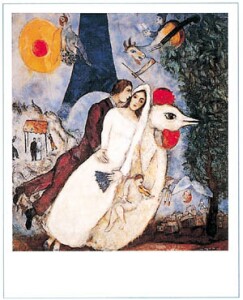Les fiancées Chagall

Poster Chagall Les fiancées - 60x80 cm
| Code | Masse in cm | Grammatur in m2 | Preis € |
Bestell- menge |
||
|---|---|---|---|---|---|---|
| Blatt | ||||||
Les fiancées Chagall -
Marc Chagall (English pronunciation: /??????l/ sh?-gahl;[1] ;Russian: ???? ?????????? ??????;Yiddish: ????? ???????; 24 June 1887 (OS)/6 July 1887 (NS) – 28 March 1985), was a Russian-French Jewish artist associated with several major artistic styles and one of the most successful artists of the 20th century. He was an early modernist, and created works in virtually every artistic medium, including painting, book illustrations, stained glass, stage sets, ceramic, tapestries and fine art prints.
Art critic Robert Hughes referred to Chagall as "the quintessential Jewish artist of the twentieth century." According to art historian Michael J. Lewis, Chagall was considered to be "the last survivor of the first generation of European modernists." For decades, he "had also been respected as the world's preeminent Jewish artist." Using the medium of stained glass, he produced windows for the cathedrals of Reims and Metz, windows for the United Nations, and the Jerusalem Windows in Israel. He also did large-scale paintings, including part of the ceiling of the Paris Opéra.
Before World War I, he traveled between St. Petersburg, Paris, and Berlin. During this period he created his own mixture and style of modern art based on his idea of Eastern European Jewish folk culture. He spent the wartime years in Soviet Belarus, becoming one of the country's most distinguished artists and a member of the modernist avante-garde, initiating the Vitebsk Arts College before leaving again for Paris during 1922.
He had two basic reputations, writes Lewis: as a pioneer of modernism and as a major Jewish artist. He experienced modernism's "golden age" in Paris, where "he synthesized the art forms of Cubism, Symbolism, and Fauvism, and the influence of Fauvism gave rise to Surrealism." Yet throughout these phases of his style "he remained most emphatically a Jewish artist, whose work was one long dreamy reverie of life in his native village of Vitebsk."[2] "When Matisse dies", Pablo Picasso remarked during the 1950s, "Chagall will be the only painter left who understands what colour really is."
Early life and education
Marc Chagall, born Moishe Shagal, was born in Liozna,[4] near the city of Vitebsk (Belarus, then part of the Russian Empire) in 1887.[5][6] At the time of his birth, Vitebsk's population was about 66,000, with half the population being Jewish.[2] A picturesque city of churches and synagogues, it was called "Russian Toledo", after a cosmopolitan city of the former Spanish Empire. As the city was built mostly of wood, little of it survived years of occupation and destruction during World War II.
Chagall was the eldest of nine children. The family name, Shagal, is a variant of the name Segal, which in a Jewish community was usually possessed by a Levitic family.[7] His father, Khatskl (Zakhar) Shagal, was employed by a herring merchant, and his mother, Feige-Ite, sold groceries from their home. His father worked hard, carrying heavy barrels but earning only 20 roubles each month. Chagall would later include fish motifs "out of respect for his father", writes Chagall biographer, Jacob Baal-Teshuva. Chagall wrote of these early years:
Day after day, winter and summer, at six o'clock in the morning, my father got up and went off to the synagogue. There he said his usual prayer for some dead man or other. On his return he made ready the samovar, drank some tea and went to work. Hellish work, the work of a galley-slave. Why try to hide it? How tell about it? No word will ever ease my father's lot... There was always plenty of butter and cheese on our table. Buttered bread, like an eternal symbol, was never out of my childish hands.[8]
One of the main sources of income of the Jewish population of the town was from the manufacture of clothing that was sold throughout Russia. They also made furniture and various agricultural tools.[9] From the late 18th century to the First World War, the Russian government confined Jews to living within the Pale of Settlement, which included modern Ukrainia, Belarus, Poland, and the Baltic states. This caused the creation of Jewish market-villages (shtetls) throughout today's Eastern Europe, with their own markets, schools, hospitals, and other community institutions.[10]:14
Most of what is known about Chagall's early life has come from his autobiography, My Life. In it, he described the major influence that the culture of Hasidic Judaism had on his life as an artist. Vitebsk itself had been a center of that culture dating from the 1730s with its teachings derived from the Kabbalah. Goodman describes the links and sources of his art to his early home:
Chagall's art can be understood as the response to a situation that has long marked the history of Russian Jews. Though they were cultural innovators who made important contributions to the broader society, Jews were considered outsiders in a frequently hostile society... Chagall himself was born of a family steeped in religious life; his parents were observant Hasidic Jews who found spiritual satisfaction in a life defined by their faith and organized by prayer.
